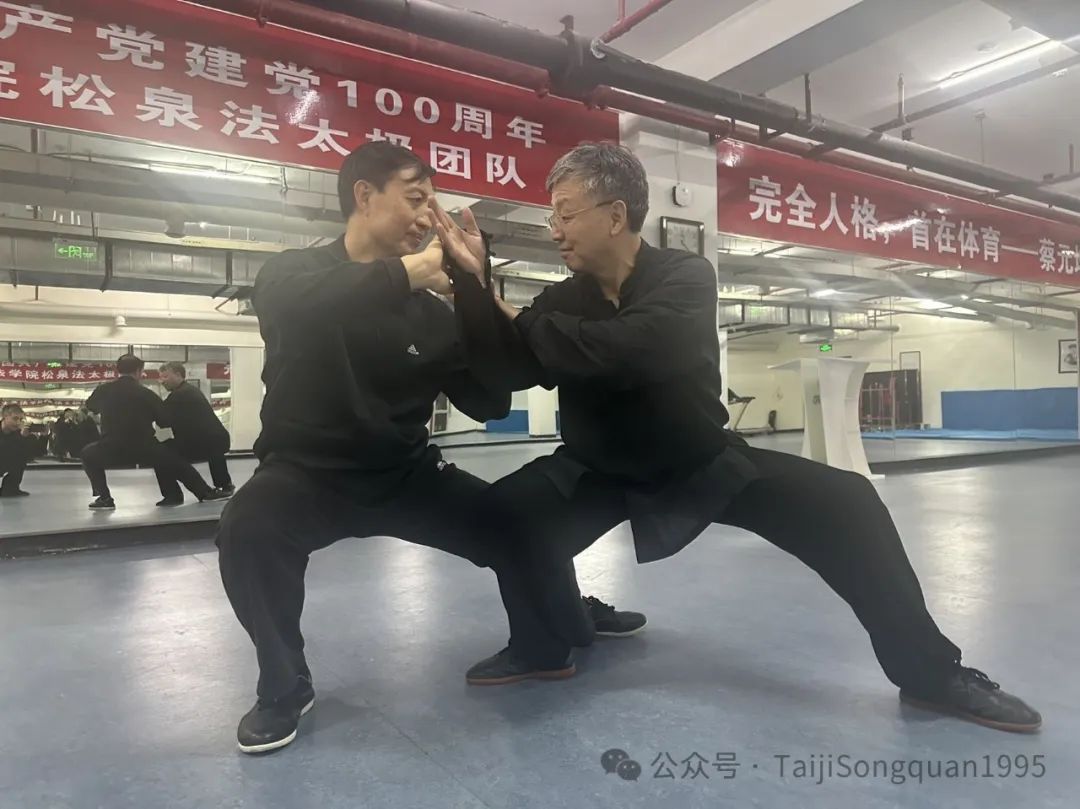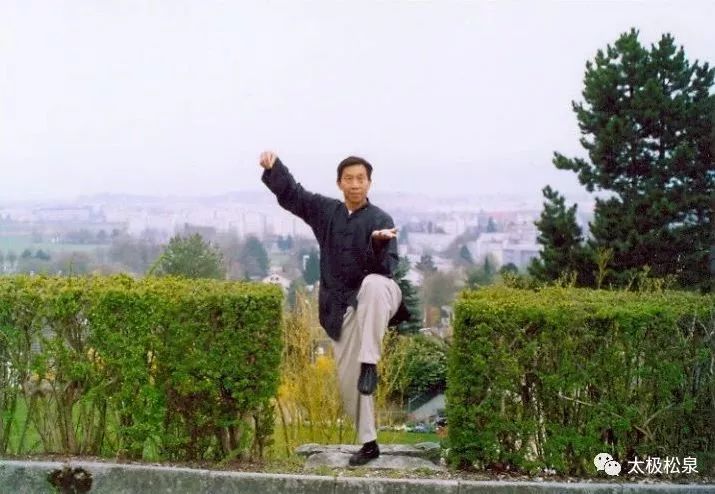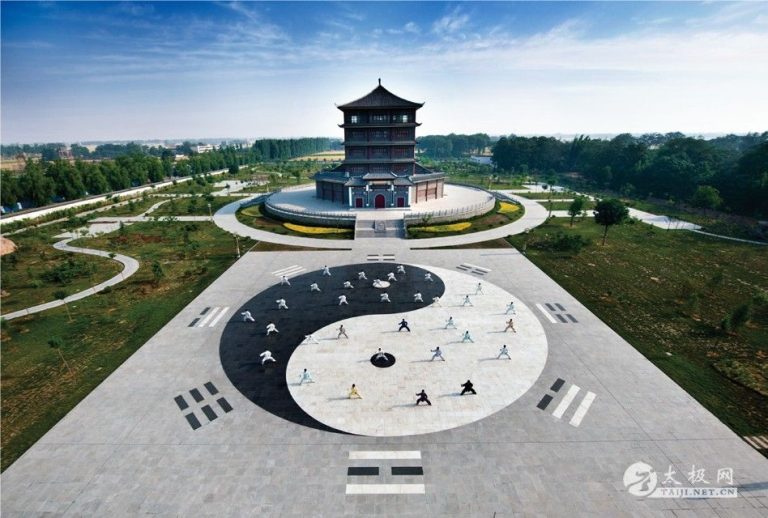Taiji Songquan· Promote the Dao and cultivate righteousness
Unforgettable Memories, moving forward with the Great Way in Mind (Part 1)

The master gazed into the distance at the foot of the Boya Pagoda and by the Weiming Lake
It’s been a year since our master passed away. We miss him all the time. His voice and appearance are still fresh in our minds, and the scenes of him teaching martial arts are still vivid. A short article I wrote, “Promoting the Dao and Cultivating the Right – Traditional and Authentic Chen-style Tai Chi Enters the School”, is included in my master’s last work, “Taiji is the Dao”. It records the mental journey of following my master and comprehensively reflects his superb Tai Chi skills and noble professional ethics. Here, we won’t discuss the master’s boxing and mental techniques. Instead, we want to remember the master’s spirit of solving doubts from another perspective. During the process of practicing boxing, I had countless confusions, but my master always easily solved the mysteries in my heart.
Question: In the golden autumn of 2011, I met my master at Yan Yuan. After a few Tai Chi classes, I raised a sharp question to my master: My body is rather stiff and cannot meet the requirements of Tai Chi. For instance, I can’t stand steadily at the beginning of the step in the “Jin Gang Pounding the Mortar” game, and my hands can’t pass over my knees in the “Hugging the Knees” game. Am I not quite used to Tai Chi? The master said, “The essence of Tai Chi is boundless, and boundless gives rise to Taiji.” Human beings are the crystallization of the balance of Yin and Yang from the father’s essence and mother’s blood. After birth, the life gate is not closed, so they possess the nature of heaven and earth. The movements of an infant are Taiji. After the age of three, if the life gate is closed, the innate nature will be completely extinguished. As people grow up, their bodies become increasingly stiff and their stiffness increases. Practicing Tai Chi can open the life gate, moisten the joints and lengthen the tendons. When you start learning Tai Chi, keep a higher stance, take smaller steps, and proceed step by step. It varies from person to person. If you persist for a long time, your body will become increasingly flexible and you will reach the realm of Tai Chi. After my master’s words, I finally untied the knot in my heart. Since then, I have been practicing for thirteen years and my body has changed a lot.
Question 2: In the past, I was quite busy with work and sometimes missed my Tai Chi classes. How did I handle the relationship between work and Tai Chi? The master said, “Tai Chi is a matter of fate. With fate, it won’t interfere with work.” As long as one has respect, tranquility and purity in their heart, they can cultivate themselves in the place where they lie down in their spare time. Learning boxing must be passed down orally and mentally by a master; it cannot be learned from videos. If there is a conflict between work and boxing classes, work first. During your spare time, you can review the old classes. When you come back, wait for your master to be free and make up for the missed classes. Over the years, I have been doing this as my master instructed. Whenever I was on business trips or traveling at home and abroad, I practiced boxing at any time without interruption. When I returned to Beijing, my master patiently gave me extra lessons.
Question 3: I have a wide range of interests in sports and have also participated in some amateur competitions. Is there any contradiction between Tai Chi and sports? How should I handle the relationship between the two? The master said, “There are differences between labor, activity and sports. Labor is glorious but harmful to the body. Activity is a sport. One strives for honor but consumes blood and sweat. Tai Chi is a sport. It nourishes the body and develops the third potential.” If you like sports, you can participate, but it must be related to Tai Chi. Pay attention to a few points: First, you can take part in swimming, badminton (including tennis and golf), and some traditional sports (such as shuttlecock kicking and ring pushing). The second is to practice Tai Chi before doing sports to warm up and after exercising to relax the body. Thirdly, when participating in sports, one can lift their feet, stretch their legs, and rotate their waist, just like practicing Tai Chi, achieving twice the result with half the effort. The fourth point is that entertainment is the main focus and academic performance is secondary. I play badminton once a week (occasionally twice), always following my master’s teachings. I enjoy playing badminton very much and have never got injured.
Question Four: During the process of a boxing class, when the master or coach leads the boxing, some students either lag behind or fail to keep up with the master or coach. How can one achieve a consistent pace? The master said, “There is a big difference between practicing Tai Chi and dancing. Dancing requires uniformity, but practicing Tai Chi varies from person to person and it is not necessary to be in step.” However, in a dojo, a harmonious energy field is needed, maintaining a state of neither opposition nor loss; otherwise, one will not be able to sense the master’s will and strength. To exceed your master’s speed is to reach the top; to be too slow is to lose. When a student punches, if they are 0.3 to 3 seconds slower than their master, they should be in a harmonious state of neither hitting nor missing, and there is no need for uniformity. When I started learning boxing, sometimes I couldn’t grasp it, but with my master’s words in mind, I persisted and have reached such a state.
Question 5: There are many people in society who practice Tai Chi and like to use music. Some of the sounds are very loud. Here, we basically don’t use music. How do you evaluate this? The master said, “Tai Chi itself has the rhythm of music. Performing a set of Tai Chi is a melody. Tai Chi directs the music, not the other way around (dancing is the opposite, music directs dancing). When performing Tai Chi, the music is only for the audience to enjoy, while a good Tai Chi practitioner moves freely with their body opening and closing and their breath flowing smoothly, rather than following the music.” So, we learn boxing without using music. There is no need to be annoyed when others use music to practice Tai Chi or dance. We should practice our own Tai Chi. This is the composure to find peace in the midst of chaos. My master’s words enlightened me. Sometimes, when some people do square dancing, I can quietly practice Tai Chi beside them.
Question 6: Although there are many benefits to practicing Tai Chi, during the process of learning it, some minor health issues have emerged. I have also encountered similar problems, such as knee pain, eczema, and sores. How should I deal with them? The master said, “Practicing Tai Chi is like the journey to the West where the scriptures are obtained. Only after going through eighty-one difficulties can one achieve the ultimate goal. It’s normal to have some minor problems when learning Taiji because practicing Tai Chi can detoxify from a deep level, which only shows up on the skin surface.” If you persist in practicing Tai Chi for a period of time, these minor ailments will be cured and the swelling of your knees will naturally subside. When dealing with these problems, during the process of practicing Tai Chi, it is strictly forbidden to swing the knees. Instead, use a horizontal “8” shape movement. When practicing Tai Chi with accumulated strength for a hundred days, if there is stagnation of qi, quick Tai Chi can be used. If there is eczema or sores, apply sesame oil to the foam. My master’s words came true for me. After three, eight and ten years of practicing boxing, I had three severe knee pains. After the swelling subsided, I was completely fine. A hard lump the size of an egg appeared on the back of my right foot near my ankle. After 38 days, it completely disappeared.
Question 7: People who practice Taiji often have a chivalrous spirit and enjoy practicing weapons. I am no exception. So, what is the relationship between Tai Chi and weapons? How to practice well? The master said, “Learning Tai Chi is the foundation of the weapons. Only after mastering Tai Chi well and grasping the boxing techniques and mental methods can learning the weapons be easily achieved. Tai Chi is like a big tree, while Taiji weapons are like fruits.” There are many weapons in Taiji, like eighteen types of weapons. According to the trainees’ own interests, they can choose a few. The commonly used ones include single sword, single saber, double sword, double saber, staff, Spring and autumn broadsword, spear, etc. Generally, they are arranged in the order of easy to difficult. Practicing Taiji equipment can also promote each other in Tai Chi. The single sword develops the gentle force, the single saber develops the explosive force, the double sword and double saber develop the coordinated force, the staff develops the powerful force, the Spring and Autumn broadsword develops the entanglement force, and the spear develops the adhesion, connection and random force. To learn Taiji weapons, one must learn from one’s father and keep practicing. Memorizing and reciting the names of the scores can help you understand the key points and achieve twice the result with half the effort. Before learning the equipment, it is better to do a round of boxing to warm up with activities. After learning Tai Chi for two years, I began to learn Taiji weapons from my master. Over the past few years, I have learned single swords, single knives, double swords and sticks, all of which were personally passed down by my master. I have benefited a lot from them. Before learning new weapons each time, the master picked out the ones he had used in the martial arts school for me. He had already kept them as treasures. Looking at them, I was moved to tears.
Question 8: In society, there are some people who learn Tai Chi. Some learn standing postures first and then Tai Chi, while others learn Tai Chi first and then standing postures. How should we understand this? The master said, “Tai Chi Chuan is based on the principle of Taiji. As it is inseparable from Yin and Yang everywhere, it is called Tai Chi Chuan.” Taiji is the metaphysical way, while Tai Chi Chuan is the material tool. Tai Chi Chuan consists of postures, and the seventy-six postures are seventy-six living postures. Tai Chi Chuan goes through three stages: mastering the movements, understanding the force, and being divine. Only when one reaches the advanced stage and the body is relaxed and heavy can they stand in a fixed position. Otherwise, standing in a fixed position first will be a dead position rather than a live one, which will cause stiffness and a stiff head. The master depends on the condition of the apprentice or the student before allowing the disciple to learn standing meditation. A few years ago, my master didn’t allow me to learn standing meditation. After three years of learning Tai Chi, my master spent several years shaping the frame for me several times and taught me four types of pushing hands at the same time. Only when my body was relaxed and deep to a certain extent did I learn standing meditation. In the autumn of 2020, my master taught me to stand in the “1” posture. In the autumn of 2021, I learned the “2” posture. And in the autumn of 2022, I learned the “3” posture. My master patiently taught me both the appearance and the essence of the posture. Over the course of three years, I have truly mastered the standing posture. A sense of righteousness spontaneously arises within me, and I am deeply grateful to my master.
Question 9: Tai Chi practitioners have different goals. Some want to learn health preservation, some want to learn performance, and some want to learn martial arts. How should we understand this? The master said, “These viewpoints are biased. Tai Chi is an internal martial art that integrates the three major functions of health preservation, performance and competition. Health preservation can keep the body healthy, performance can cultivate one’s sentiment, and competition can make friends.” The practice of Tai Chi develops the third potential, which is the innate natural 炁 stream. Youdaoplaceholder0 WHEN flowing, open all the gates, remove filth, moisten the skin, strengthen the muscles and bones, nourish the internal organs, cure all diseases. Tai CHI, THE heaven and earth 炁 also. That is the middle and right 炁, that is “one”. One righteous person can ward off all evil. Therefore, it is often said: Tai Chi does not strike people; Tai Chi makes even gods and ghosts afraid. Its combat nature stems from nature, not from fighting with hands. It is 炁 also, soft to hard. Be as strong as a swift wind and thunder to shock the other party, and as gentle as a gentle breeze and drizzle to dissolve them. This is the ultimate and simple way of promoting the Tao and cultivating righteousness as the master spoke of. We will always keep it in mind.

“Harmony!”
Disciple Wang Jiancheng
Written in Yanyuan Study on November 28, 2024
(Continue from the next part
The training center is always open to both new and old students for sharing their insights and experiences on learning boxing, as well as memories and commemorations of Master Yang Songquan. The genre and theme are not limited. We welcome your submissions to the email:
taijisongquan@126.com
Thank you all for your active participation.
Taiji Songquan Respectfully begins
Taiji practitioner
Born of the boundless, it is the mechanism of movement and stillness, and the mother of Yin and Yang
Tai Chi is
The rhythm of music and the connotation of philosophy
The construction of beauty, the artistic conception of poetry

Encounter Taiji, encounter the gift of life







